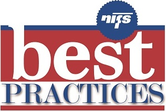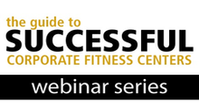I shared a few months ago about our staff following the KISS principle (that’s “keep it super simple” in our world!) on an exercise-based program with one of our clients. (You can find out more about the NIFS150 corporate fitness program here.) I wanted to update you on that program’s outcomes and talk about our latest challenge.
 One of the outcomes we saw from that program was that a lot of the participants did not exercise in the corporate fitness center during the initiative, and frankly, that was by design. We were mostly interested in supporting and inspiring employees to achieve 150 minutes of activity each week, so we eliminated the “must be accomplished in the corporate fitness center” barrier by allowing participants to log any activity accomplished anywhere. After all, the primary job of our fitness center managers and health fitness specialists is to get employees moving. If it’s activity in the corporate fitness center, even better. But with today’s frantic schedules, we’ll take any movement, anywhere, anytime.
One of the outcomes we saw from that program was that a lot of the participants did not exercise in the corporate fitness center during the initiative, and frankly, that was by design. We were mostly interested in supporting and inspiring employees to achieve 150 minutes of activity each week, so we eliminated the “must be accomplished in the corporate fitness center” barrier by allowing participants to log any activity accomplished anywhere. After all, the primary job of our fitness center managers and health fitness specialists is to get employees moving. If it’s activity in the corporate fitness center, even better. But with today’s frantic schedules, we’ll take any movement, anywhere, anytime.
The Active Summer Adventure Program (ASAP)
In another creative effort designed to help employees make healthy choices across the spectrum of health (not just fitness), our staff created the Active Summer Adventure Program (ASAP) challenge. In this unique corporate wellness program built on a theme of exploration, participants have the following weekly challenges to complete:
- Hydration Lagoon: Drink 64 ounces of water each day of the week.
- Adventure Park: Try a new outdoor activity.
- Meditation Meadow: Practice meditation, breathing exercises, or stretches on four days this week.
- Fitness Fountain: Try a new group exercise class, DVD, or at-home workout.
- Traveling Trail: Accumulate at least 7,000 to 10,000 steps one day this week.
- Feel-Good Farm: Pack a healthy lunch three days during the week.
- Progress Paradise: Complete two fitness center screenings (BMI, circumference, blood pressure, body composition, resting heart rate, or body weight) this week.
- Journaling Jungle: Keep a food log for three days this week.
As was the case with the NIFS150 program, our goal with the ASAP program was to make it accessible for everyone. It was promoted to all employees, including those who work at home. We ran it over summer months when it can be particularly challenging to attract employees into the corporate fitness center. The online registration and website access for weekly challenges made it simple for all participants to have the information they needed to be successful.
And, in keeping with many of our programs, we offered prize drawings for employees who successfully completed all eight quests. Consistent with the “adventure” theme of the program, most prizes were experience-oriented (such as tickets to theme parks, state park passes, and surfing lessons) rather than stuff-oriented (such as wearable tech, shirts, and gym bags).
ASAP Employee Wellness Results
In a post-program survey we learned that almost 84% of responders believed they adopted a new healthy behavior by participating in ASAP. And that’s consistent with their rating of “accountability to try something new” as their favorite program feature. Participants also reported learning something new about health during this program. Although weight loss was not a focus for this program, 43% of survey respondents reported losing weight or inches during the eight-week offering. Almost 60% reported having more energy, and about one-quarter of participants indicated that they were sleeping better. Through the post-program survey, we also gained valuable insights on how we can improve the program if we offer it again next year.



 Businesses need top performers in order to survive. We need sales staff who are heavy hitters, research staff who are actually rocket scientists, and customer service professionals who can turn any frown upside down. You know who those folks are in your organization, that top 5% of all performers. In some cases, they might be unsung heroes, but at a lot of businesses, the best among us are often publically lauded. They are the elite.
Businesses need top performers in order to survive. We need sales staff who are heavy hitters, research staff who are actually rocket scientists, and customer service professionals who can turn any frown upside down. You know who those folks are in your organization, that top 5% of all performers. In some cases, they might be unsung heroes, but at a lot of businesses, the best among us are often publically lauded. They are the elite.

 According to a study published in the
According to a study published in the 

 Tami is a determined woman. She began as a secret exerciser doing her own thing. She is now a bold woman with confidence willing to try everything she can. She actively recruits co-workers to join her for exercise sessions at the onsite corporate fitness center in their workplace and is always game to try new exercises. It has been fantastic to be able to get to know Tami during the past few years.
Tami is a determined woman. She began as a secret exerciser doing her own thing. She is now a bold woman with confidence willing to try everything she can. She actively recruits co-workers to join her for exercise sessions at the onsite corporate fitness center in their workplace and is always game to try new exercises. It has been fantastic to be able to get to know Tami during the past few years. My exercise routine started out by playing the activity games, step aerobics, yoga, stretching, “running”/jumping in place, etc. for approximately 5 days a week for 45 minutes or more. I also had access to a gym, which after a month or so of the Wii, was my next mode of exercise. I would wake up at 3:50 in the morning in order to make it to the gym, make it back home in time to wake my daughter up for school, and get to work by 7:30 am. It was hard at first, but the weight was starting to really come off and I loved seeing the results and feeling good. By April, I was jogging on the treadmill with a 12 minute mile. Wow! I couldn’t believe I was “running”! At that point I was hooked….I loved running!
My exercise routine started out by playing the activity games, step aerobics, yoga, stretching, “running”/jumping in place, etc. for approximately 5 days a week for 45 minutes or more. I also had access to a gym, which after a month or so of the Wii, was my next mode of exercise. I would wake up at 3:50 in the morning in order to make it to the gym, make it back home in time to wake my daughter up for school, and get to work by 7:30 am. It was hard at first, but the weight was starting to really come off and I loved seeing the results and feeling good. By April, I was jogging on the treadmill with a 12 minute mile. Wow! I couldn’t believe I was “running”! At that point I was hooked….I loved running!
 Sherri Pryor came to me in our corporate fitness center after starting this journey on her own. She was determined to continue to make positive changes in her life. She was definitely apprehensive about talking to me at first. However, she has overcome her own insecurities to become a stronger and more confident version of herself than the woman that first came to me three years ago. There have been goals set, goals achieved, and goals missed, but through it all she has always kept a positive attitude. This attitude has helped her become the best version of herself she can be. Here is her story!
Sherri Pryor came to me in our corporate fitness center after starting this journey on her own. She was determined to continue to make positive changes in her life. She was definitely apprehensive about talking to me at first. However, she has overcome her own insecurities to become a stronger and more confident version of herself than the woman that first came to me three years ago. There have been goals set, goals achieved, and goals missed, but through it all she has always kept a positive attitude. This attitude has helped her become the best version of herself she can be. Here is her story! I started this process in early 2012; I was committed more than I had ever been in my life to making changes, exercising more and improving my personal wellness. I was tired of feeling like I had no control over how I felt and looked. There are so many things in life that we truly can’t control. Making time for exercise and doing things to improve your overall health are not on that list. It was hard at first; but it got easier with time.
I started this process in early 2012; I was committed more than I had ever been in my life to making changes, exercising more and improving my personal wellness. I was tired of feeling like I had no control over how I felt and looked. There are so many things in life that we truly can’t control. Making time for exercise and doing things to improve your overall health are not on that list. It was hard at first; but it got easier with time.


 When our members talk, we listen. Sometimes we get good old fashioned direct, face-to-face feedback about what’s working and what isn’t, and sometimes they tell us what’s working by their participation. Such was the case with a recent squat challenge we ran at one of our corporate sites. In fact, the simple challenge was so effective, we’ve proceeded to design more programming around the same concept.
When our members talk, we listen. Sometimes we get good old fashioned direct, face-to-face feedback about what’s working and what isn’t, and sometimes they tell us what’s working by their participation. Such was the case with a recent squat challenge we ran at one of our corporate sites. In fact, the simple challenge was so effective, we’ve proceeded to design more programming around the same concept.